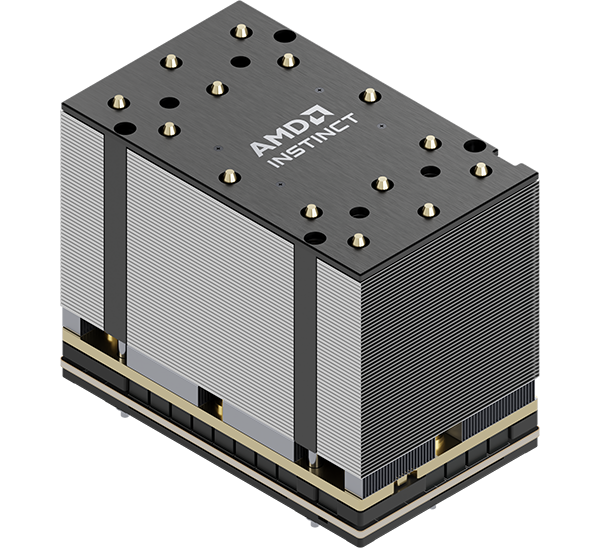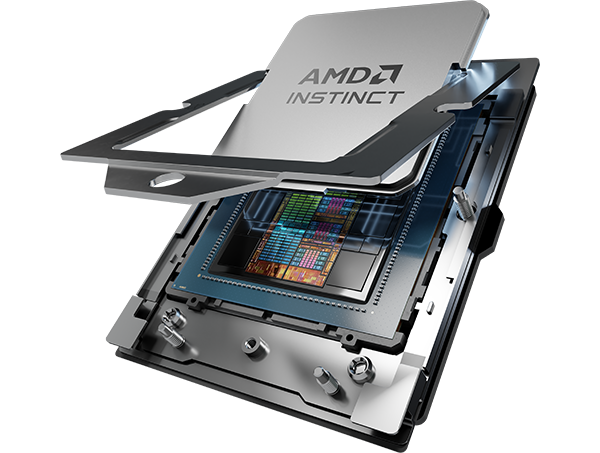AMD Instinct™ MI300 Series Platform
Accelerators for the Exascale Era
A Discrete GPU and a Data Center APU
Select GIGABYTE for the AMD MI300 Series Platform
-
High Performance
The custom 8-GPU baseboard server ensures stable and peak performance from CPUs & GPUs as priority was given to signal integrity and cooling.
-
Scale-out
Multiple expansion slots are available to be populated with ethernet or InfiniBand NICs for high-speed communications between interconnected nodes.
-
Energy Efficiency
Real-time power management, automatic fan speed control, and redundant Titanium PSUs ensure the best cooling and power efficiency. Also, DLC option.
-
Compute Density
Offering industry leading compute density in a 5U chassis (G593 series) and 3U chassis (G383 series), servers achieve greater performance/rack.
-
Advanced Cooling
With the availability of server models using direct liquid cooling (DLC), CPUs and GPUs can be cooled faster with liquid cooling than air.
AMD Instinct™ MI300 Series Accelerators Specifications
 AMD Instinct™ MI325X & MI300X GPU
AMD Instinct™ MI325X & MI300X GPU
 AMD Instinct™ MI300A APU
AMD Instinct™ MI300A APU
| MI325X GPU | MI300X GPU | Model | MI300A APU |
|---|---|---|---|
| OAM module | Form Factor | APU SH5 socket | |
| - | AMD ‘Zen 4’ CPU cores | 24 | |
| 304 | GPU Compute Units | 228 | |
| 19,456 | Stream Processors | 14,592 | |
| 163.4 TFLOPS | Peak FP64/FP32 Matrix* | 122.6 TFLOPS | |
| 81.7/163.4 TFLOPS | Peak FP64/FP32 Vector* | 61.3/122.6 TFLOPS | |
| 1307.4 TFLOPS | Peak FP16/BF16* | 980.6 TFLOPS | |
| 2614.9 TFLOPS | Peak FP8* | 1961.2 TFLOPS | |
| 256 GB HBM3E | 192 GB HBM3 | Dedicated Memory Size | 128 GB HBM3 |
| 6.0 GHz | 5.2 GHz | Memory Clock | 5.2 GHz |
| 6 TB/s | 5.3 TB/s | Memory Bandwidth | 5.3 TB/s |
| PCIe Gen5 x16 | Bus Interface | PCIe Gen5 x16 | |
| 8 | Infinity Fabric™ Links | 8 | |
| 1000W | 750W | Maximum TDP/TBP | 550W / 760W (Peak) |
| Up to 8 partitions | Virtualization Support | Up to 3 partitions | |
* Indicates not with sparsity
Applications for AMD Instinct MI300 Series
-
Generative AI
8-GPU UBB based servers are ideal for generative AI because of the parallel processing nature of the GPU. Parallel processing is great for massive training data sets and running deep learning models like neural networks, and it speeds up applications like natural language processing and data augmentation.
-
HPC
Complex problem solving in HPC applications involves simulations, modeling, and data analysis to achieve greater insights. Parallel processing from the GPU is needed, but also there is heavy reliance on the CPU for sequential processing in mathematical computations.
-
AI Inference
High memory bandwidth, large memory capacity, and low latency between GPUs are ideal for AI inference for their ability to handle large data sets and processing data in batches. This is important for real-time or large-scale inference applications.
Featured New Products
Resources






























